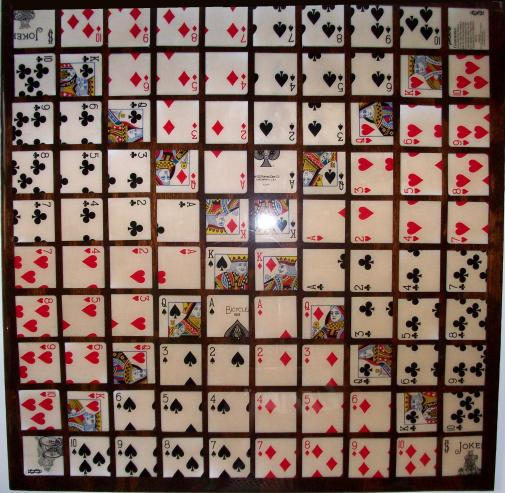

At the end of their turn, the player draws a new card from the draw deck, after which play passes to the player to the left.Ī player may place chips on either of the appropriate card spaces as long as it is not already covered by a marker chip of any color. One-Eyed Jacks cannot be used to remove a marker chip that is already part of a completed sequence once a sequence is achieved by a player or team, it stands.Įach played card then goes face-up into a "Discard" pile. Players may use the Two-Eyed Jacks to complete a row or block an opponent, while One-Eyed Jacks can remove an opponent's advantage. One-Eyed Jacks allow whoever played one to remove an opponent's chip from a space. Two-Eyed Jacks are considered wild cards and may be used to place a chip on any open space on the board. On their turn, the player chooses a card from their hand to play, then places a marker chip on one of the corresponding spaces of the game board (Example: An Ace of Diamonds is played from a player's hand that player places a chip on the Ace of Diamonds on the board). The player to the left of the dealer goes first.

Each player or team then chooses a set of poker chips all members of each team share chips of the same color (Blue and green chips are always used, while red chips are only used for three-player or three-team games). The player with the lowest card becomes the dealer, and the cards are shuffled again. Each player cuts the deck by taking as many card from the deck as they want, then flips their card stack over. To decide who goes first, all the cards are shuffled into a single deck.

The jokers, if any, are removed from the deck as they are not used in the game.

The game board is placed on a flat surface (such as the floor or a table) with enough room to allow for the game board, the draw deck, the discard pile(s) and marker chips. With three teams, players of a team must be positioned at every third player around the playing surface. With two teams, players alternate their physical positions with opponents around the playing surface. If there are more than three players, all players have to be divided evenly into two or three teams before the start of the game (The game cannot be played with 5, 7, or 11 players). Sequence can be played with 2 to 12 players.
#SEQUENCE BOARD GAME IMAGE NO JOKERS FULL#
Playing Board 19 + 3⁄ 4 by 15 + 1⁄ 4 inches (500 mm × 390 mm) Instructions 135 poker chips (50 blue, 50 green, 35 red) two full standard card decks (52 cards each, 104 cards total may also contain jokers). The object of the game is to form a row of five poker chips, called a sequence, on the board by placing the chips on the board spaces corresponding to cards played from the player's hand. Doug Reuter is acknowledged as the inventor of Sequence on all newly produced copies of the game - both on the box and in the printed rules. In 2017, Goliath Game Company bought Jax, and in early 2018 also bought all licensor rights and now owns 100% of the game Sequence. The game was first sold in a retail store in 1982.
#SEQUENCE BOARD GAME IMAGE NO JOKERS LICENSE#
an exclusive license to manufacture, distribute and sell the board game Sequence and its subsequent variations. He spent years developing the concept, and, in June 1981, granted Jax Ltd. They originally called the game Sequence Five. Sequence was invented by Douglas Reuter and Hamish. Sequence is an abstract strategy tabletop party game. For the video game also known as Sequence, see Before the Echo.


 0 kommentar(er)
0 kommentar(er)
